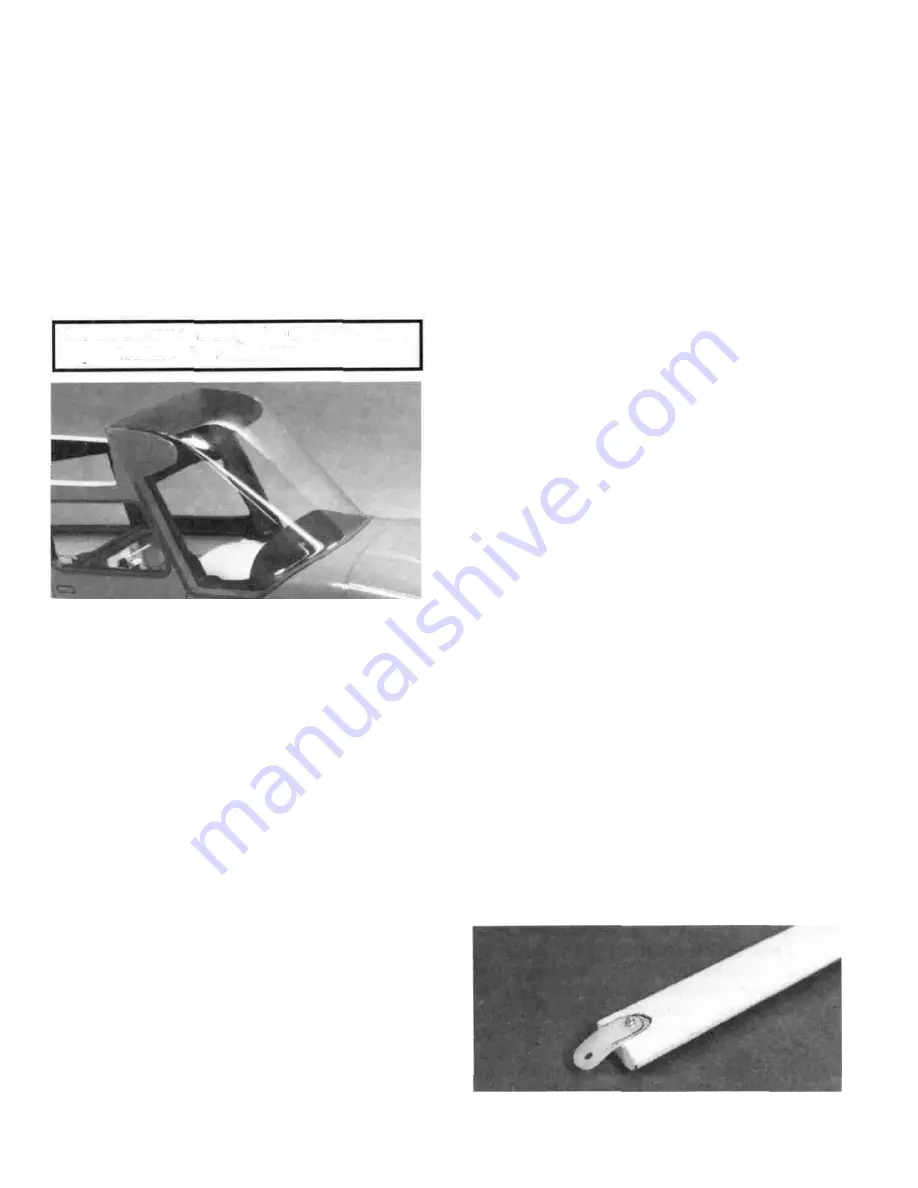
NOTE: Do not glue the windshield in place until after
you have covered your model.
D 3. Lightly sand the inside of the windshield around the
outside edge (sand a strip approximately 1/8" wide). NOTE:
To avoid sanding more than you want, it is helpful to first
apply strips of masking tape on the inside of the windshield,
1/8" in from the edges.
D 4. Hold the windshield in place on the fuselage and
very carefully apply medium to thick CA glue around the
edges. The CA will wick under the windshield slightly and
will bond the windshield to the covering material.
NOTE: Use care to avoid getting CA on the outside
exposed surface of the windshield.
D 5. To hide the windshield glue joint, you may use 1/8"
red striping tape as a border around the windshield.
WING SEATING
D 1. Apply 1/4" wide foam wing seating tape to the wing
saddle area to seal the wing/fuse joints*.
D 2. Also apply a couple pieces of the foam tape to the
1/4" ply wing hold-down plate, which helps to distribute the
load when the nylon bolts are tightened.
*NOTE: An alternate method of sealing the wing/fuse
joint is to use "silicone bathtub sealer". This is an
excellent method, used by many experts because it
results in a permanent and nearly perfect wing saddle
joint. Briefly, the technique is as follows: 1. Cover the
bottom of the wing center section with waxed paper or
plastic kitchen wrap. Pull out all wrinkles and tape it to
the wing. 2. Squeeze out a bead of silicone sealer onto
the wing saddle area of the fuselage. 3. Lay the wing in
the saddle and push down gently. The excess silicone
sealer will squeeze out. 4. Allow to dry without
disturbing for at least 24 hours. 5. Remove the tape, then
remove the wing from the saddle (leaving the waxed
paper or plastic wrap in place). 6. Gently pull the waxed
paper or plastic wrap away from the sealer. 7. Allow the
silicone to dry for a few more hours. 8. Using a new
single-edge razor blade, trim the sealer flush with the
edges of the fuse sides.
INSTALL WING STRUTS
NOTE: The wing struts are for scale appearance
only. Built according to the plans and instructions, the
structure has sufficient strength for normal acrobatic
flying (within the boundaries of common sense).
NOTE: Before proceeding, make sure that you
have the wing seated and installed on the fuselage in its
Final position. Skip ahead to the "FINAL HOOKUPS
AND CHECKS" section, and check for wing twist as
instructed. Also, study the wing strut detail drawings
on the plan.
D 1. Sand the 1/4" x 5/8" x 24" and the 5/16" x 3/4" x 24"
balsa sticks to an airfoil shape. The 3/4" slicks make the front
struts, and the 5/8" sticks make the rear struts.
D 2. By measurement, determine the location of the
center of the wing strut plates on the bottom of the wing, and
drill 5/64" holes at these locations. Secure the drilled ends of
the nylon straps to the wing with #4 x 3/8" sheet metal screws.
D 3. Cut the 3/4" front wing struts to the proper length.
Sand the end of the strut closest to the fuselage at an angle so
it lays flat against the fuse side.
IMPORTANT NOTE: The struts could adversely
affect the way the airplane flies if not installed properly!
Please use care to align the struts parallel with the line
of flight.
D 4. Drill 1/8" holes in the strut ends at the strut strap hole
locations. Carve out an area on top of the strut ends to recess
36
Summary of Contents for Super Decathlon 40
Page 4: ...DIE PATTERNS Usethis drawing to help you identify the die cutparts 4...
Page 42: ...42...
Page 43: ...43...









































